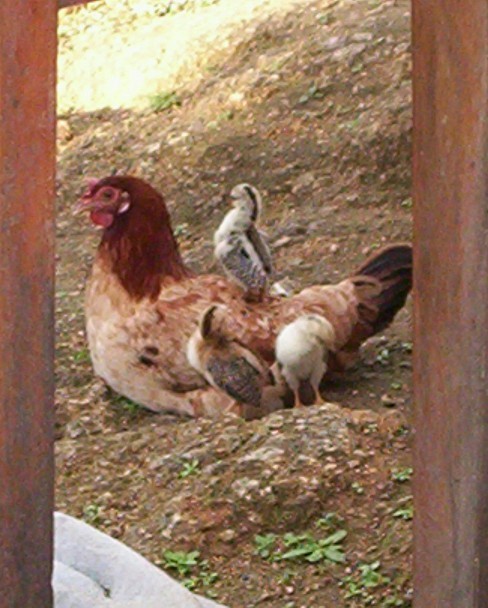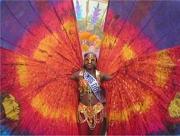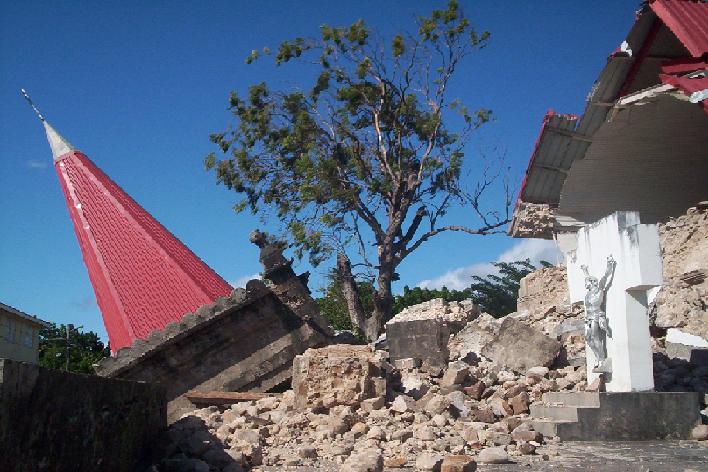|
|
|
 |
Custom Page 3 |  |
|
Little Chickadee As a Biomedical Engineer from Milwaukee School Of Engineering ( MSOE ), I d never imagine I d learn so much about chickens, yet as a PCV, I m learning more all the time. I may be the first Biomedical Engineer volunteer in the history of Peace Corps yet I love what I do now. As a secondary assignment, I ve been assisting Operation Youth Quake build a chicken coop as part of a Small Project Assistance grant passed on to me by a former PCV. Unfortunately, I was not able to pass on the '' measure twice, cut once '' logic prior to the beginning of construction, due to a long wait for a bus. However, that made for an interesting and fun time correcting the mistakes of misaligned boards and crooked nails when I arrived. Getting the children involved was a great way of making them feel they ve contributed and become eager to reap the rewards ( eggs ) to soon follow. The coop is part of a larger '' life skills '' program in which disadvantaged youth learn practical skills harvesting, cooking, and selling eggs to ultimately support themselves instead of a less desired life on the streets or in jail. After completing construction of the coop, I had the children paint apartment numbers for the chickens - That was an adventure and a half ! I thought I had a fool-proof method of controlling about 20 hyperactive children, but instead ended up with my hands full and paint on anything the kids could find, including a chicken. I practically had to pull them away from their creative endeavors one at a time. Having chickens in my yard, I thought I knew them well - The chickens that is. Now part of this project, it s been explained that those '' layers '' are special chickens that are incubator hatched and will peck each other without blinders, like on New York City horses, and even their own eggs if laid on the ground. I m as eager to watch the children harvest their eggs as I am for a chicken that lays in a box at my back door. My chicken is wild and fed occasionally by my neighbor and myself. There s nothing like a fresh egg at your door in the morning, unless you forget and step on it on the way out. I had no idea chickens ate coconuts and banana peels, nor did I notice they wiped their beaks on hard ground after eating, until this opportunity living in Canefield. One day, I decided to leave two eggs for that dedicated hen with table manners, and three weeks later, I was able to learn much more. Mother hens are protective. To avoid a mess at my back door, I got a wing smacked in my face when picking up a chick to move to a better location. Unfortunately, someone stole my little fuzz-ball chicks, named Chicken Little and Little Richard, but there were plenty more to come in the months to pass. I was surprised to see one chick born without eyes, yet the cats did not chase it - they were smart enough to meow for my tuna, but that s another story. |
||
 |
Tito Gorge Today was a much anticipated trip with OYQ to Bamboo River and the Fresh Water Lake. I was in for quite a surprise. At OYQ, boxes of premium cookies had already been ravaged, so the children were pretty much placated by the rare treat. It was a long ride in cramped vehicles, which strained from the weight on the voyage up the mountain climb through Trios Pitons National Park. Thank God road construction had begun so there were no potholes. As we climbed further towards the peak, it was noticeably cool and seemed as if we could touch the clouds lingering forever on the mountain top, looking like puffs of cotton candy. We made it to the parking platform at the end of the road (the only completed cement section) and noticed a sign stating a 45 minute hike to Bior Lake. Having taken so long and with young children, we decided against the hike and would plan it another day. Apparently, as we looked over the road-side cliff edge, the Fresh Water Lake had once been higher and OYQ had driven down there the previous year, but for some unknown reason, not today. I was quite disappointed as we drove past our destination and confused as to our next. We stopped next to the hydroelectric plant, powered by water from the lake. Long, enormous, metal pipes carried water and winded around the mountain. We followed it. Most walked on it but I chose to err on the side of caution and take a few pictures from the path below. Mr. Abraham had given me a pair of cheep batteries that barely served their purpose, but I managed to get several good shots for the day. I was presently surprised once at our destination. It was sort of a natural reservoir coming out of a deep cavern. There were steps going into it but we all just jumped in off the cliff from about 20 feet above. I took a few good pics as children lined up to jump and heard someone say the water was warm. Hearing that, I decided to go in myself. The water was crystal clear and inviting. The prospect of swimming thru a cavern with a waterfall at the end was more than enough incentive for my own high-dive plunge. The rocks, having gotten wet from the children, got slippery but I took a running jump anyway. Yeeee Owww! The water was cold! I quickly made my way to a tiny waterfall-tributary, where I discovered the source of the warm water, and stood under the waterfall for a moment. I attempted to bring the camera down in a plastic bag but, after viewing my journey ahead, decided against it. Mr. Abraham threw down my waterproof flashlight and I entered the cavern. It was like nothing Id ever seen before. At least not in person. The closest analogy I could give is right out of picture books; The wind carved formations of Utah filled with water and beams of soft light coming thru an overflow of plants from the crevice above. A few brave boys surrounded me while I swam against an increasingly strong current for nearly 300 yards. The tranquil echo of the falls reverberating off the gorge walls welcomed me into a peaceful bliss. The end of the gorge was an alcove. At that point, it was near impossible to maintain my position without the current forcing me downstream. Hanging on the alcove edge with my fingertips wedged in the small crevices of an otherwise smooth, water-carved wall, I could see the awesome beauty of the falls. Attempting to maneuver for a better view, I managed to pull myself around the edge but couldnt hold fast against the rushing water streaming around the alcove. I decided to return one day for another attempt, perhaps with my camera during a week with low rainfall. Perhaps with a waterproof camera rented from one of the dive shops. The breathtaking beauty is the epitomy of a rainforest that everyone should see. I let go of the wall and allowed to be gently carried back thru the gorge where I loudly declared my experience and appreciation. After a ritual dunking of a few children, it was time to leave. It seemed too soon but I got out, dried off, and was on my way with yet another unforgettable memory of another day in paradise. |
|
 |
Bon-Fire Pow-Wow It was the last day of the Summer Program for Operation Youth Quake. The program had been working out great for the first month but fizzed out the second, largely due to weather problems. I wanted to end it with a bang, so I brought up the idea of a bon-fire pow-wow and worked out the plans with Mr. Abraham and staff. Concerned that the food and wood wasnt being taken care of on time, I purchased a couple boxes of the only graham crackers I could find and left the marshmallows and chocolate bars up to Mary to purchase to make smores. It was difficult to fit in some education for the day, since the children were all excited about the event and inattentive, but I got four Native American tribes together and had the Chiefs give out traditional names and write stories using petroglyphs. As a reward, the two tribes that had the longest stories got to toast their marshmallows first. The fire was fun for me to build and light. I hadnt done that in quite some time. Kindling was conveniently available across the street and plenty of wood was gathered beforehand. A roaring fire was made in no time as the sun began to set. Mary and Ms. Ann were in the kitchen preparing dinner and organizing the best method of cracker and chocolate distribution into eager hands while I gave the marshmallows to the two chiefs to distribute secretly to their tribes. Before I could say Rumplestilskin, there were marshmallows hanging from hand-picked bamboo skewers over the fire. I got several good pictures of all the action. A few little ones needed help while others had flaming balls of goo flying all over. It was their first experience with smores, and I gave them a few words of wisdom to ponder, but most were too antsy to listen. They scurried with their burned marshmallows into the kitchen to have them sandwiched between two graham crackers and a piece of chocolate. The staff were as eager to try the treats as anyone but had their hands full, so I did it for them and took pictures of oozing marshmallows in their mouths and, in the case of the younger children, just about everywhere except in their mouths. It was impossible to keep count, but there were about 50 people there that night, almost entirely children. Luckily, I purchased and brought an enormous 22 pound bag of popcorn kernels to fill them up. There was plenty left over. Throughout the night, the children did their own version of tribal dance to modern radio and taunted the fire, some jumping over it in leaps of stupidity. No one was hurt by the fire, which was allowed to burn out at about 9pm, but there were a few minor injuries from burned marshmallows and a lot of lasting memories from the best OYQ day they could remember. |
|
 |
Image Obscurred - A Modern View of the Eastern Caribbean It’s a typical day in the Eastern Caribbean, not that dissimilar to the rest of the world. Everywhere people are working, talking, eating, raising children and believing as they feel best suits their lives. In the United States, we buzz around in our daily lives making desperate attempts to balance our work ethic with our family without sacrificing either. In the EC, the lifestyles are lax with an emphasis on living and relationships, out of tune with the fast-paced cultures of its northern neighbors. This chain of small islands has its own defined culture as well. The image of the EC is still not clear for most people. Tourists tend to breeze through the immediate port city or village areas from cruise ships and avoid the true nature of the islands and its inhabitants. Poverty still exists and is widespread beyond the few cities visited by the seasonal flock. The history of the island cultures can be seen with the clash of plantation houses and shacks against more modern structures. It is a laidback lifestyle, slightly displaced in time, with rapidly growing modern influences. As expected, there is much to offer for those seeking a nature adventure. The Eastern Caribbean is a culmination of a chain of islands with varied socio-cultural and eco-economic lifestyles starting with the British island of Anguilla near Puerto Rico and extending down to Grenada near Venezuela. Peace Corps currently serves on six of the EC islands, with St. Kitts its newest member. Barbuda, part of Antigua, is the northern most, with flat, tourist based 360 degree beaches and starved for rainfall. Grenada, known as the Spice Island, with its dense tropical rain forest, recently destroyed by hurricane Ivan, still contains a dedicated few volunteers. It is probably the best known island by the common American, due to the U.S. invasion in 1983, yet it continues to endure many political problems. Dominica, in the middle of this chain, is an island with rugged peaks so sharp that still today there are unexplored areas after over 500 years since discovery by Christopher Columbus. It boasts a surviving tribe of Caribs named Kalinago, is rich in history as well as nature, and is also where I serve as a Peace Corps Volunteer. As an American serving as a PCV, new perspectives are formed not acquired by the common tourist. The islands to the north enjoy more influence from the U.S. while the islands to the south benefit from strong Chinese interests, such as the recent hundreds of millions of dollars donated to Dominica. In the more remote regions of the Grenadines, beautiful small islands scattered off the south shore of St. Vincent, some island medical staff still practice the belief that ripping out a baby’s umbilical cord prevents infection. These same pristine clusters of islands were also the location filmed for Pirates of the Caribbean. It is, in fact, a clash of cultures, incomplete and unbalanced for the future. The larger cities of Castries in St. Lucia and St. Georges in Grenada are known tourist stops with their abundance of attractions, frequented by cruise ships but also plagued by the same ill fates that come with expanding economies. Dominica, sandwiched between the French islands of Martinique and Guadalupe, is an eco-paradise, agriculturally based and just beginning its tourism industry. Its French and British history is more apparent after the recent earthquake that toppled old stone churches to the northern region of Portsmouth, but it is the friendly people and rich culture it offers as an engrained part of the society that makes its uniqueness stand out. Fishermen still practice their time-honored net fishing skills in colorful boats and blow conch shells well into the night to announce their catch for sale. People of all ages celebrate festivities throughout the year in colorful costumes, such as those worn on Creole Day prior to the nation’s independence from the British just over 25 years ago, to proudly celebrate their African heritage as they did generations ago in a slave era. Originally, Peace Corps efforts in this region were in the capacity of agriculture and classroom education. Now, decades later, efforts have expanded into IT to usher in a more modern era. With that comes expanded tourism and a greater influence by its neighboring countries, yet it is a region still unknown to most Americans. It is a region barely touched, rich in culture and history, awaiting discovery in modern times.
|
|